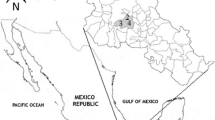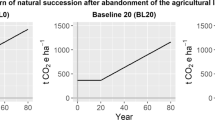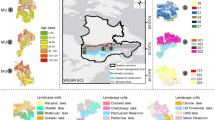Abstract
The Kyoto Protocol brought a new forest function into focus: forests as carbon sinks. This new forest function may lead to new conflicts, because on the one hand, Switzerland has decided to account for forest management under Kyoto Protocol (Article 3.4), and on the other hand, Swiss Forestry statistics and the Swiss National Forest Inventory indicate that increasing amounts of wood are being harvested. This trend seems likely to continue. In this study, we used the empirical forest model MASSIMO and the soil model YASSO to analyse four different forest management scenarios. These scenarios basically feature different levels of harvesting frequencies and different rotation length, as well as their impact on regional potentials for carbon sequestration and harvesting amounts. Results were analysed both for the whole of Switzerland and for two very different regions: The Swiss Eastern Plateau and the Swiss Eastern Alps. The results indicate that Swiss forests can provide an increasing amount of harvested wood (+18% in relation to the base year 1996) for approximately 20 years and act as a carbon sink accountable under the Kyoto Protocol (0.5 million tons carbon per year). The corresponding forest management strategy aims for a sustainable and harvestable increment and may, therefore, avoid spurious carbon maximization in forests that can happen by accounting for only forest systems, and not for the effect of substitution of non-wood products and fossil fuels by forest products. The regional results indicate that (1) the carbon sink effect of Alpine forests in Switzerland might be limited, because generally, Alpine forests have low growth and yield and (2) a large increase in harvesting may lead to regional carbon sources and necessitate regional monitoring of increment to avoid overexploitation. As MASSIMO does not include the impacts of climate change, the conclusions of this study cannot be interpreted as actual predictions into the future but portray the impact of the applied management actions on the respective trends in carbon stocks and stock changes. They are, therefore, a contribution to support future management decisions. Further studies should focus on interactions with additional forest functions such as the preservation of biodiversity, increase the consideration of forest damage and account for the effect of climate change.



Similar content being viewed by others
Notes
http://www.admin.ch/ch/d/as/2008/1223.pdf (28.08.2009).
References
Assmann E (1961) Waldertragskunde–Organische Produktion. Struktur, Zuwachs und Ertrag von Waldbeständen. BLV Vertragsgesellschaft München Bonn Wien, p 79
Birdsey R, Pregitzer K, Lucier A (2006) Forest carbon management in the United States: 1600–2100. J Environ Qual 35(4):1461–1469
Brassel P, Brändli U-B (eds) (1999) Schweizerisches Landesforstinventar: Ergebnisse der Zweitaufnahme 1993–1995. Eidgenössische Forschungsanstalt für Wald, Schnee und Landschaft (WSL). Bern, Haupt
Ciais P, Reichstein M, Viovy N, Granier A, Ogee J, Allard V, Aubinet M, Buchmann N, Bernhofer C, Carrara A, Chevallier F, De Noblet N, Friend AD, Friedlingstein P, Grünwald T, Heinesch B, Keronen P, Knohl A, Krinner G, Loustau D, Manca G, Matteucci G, Miglietta F, Ourcival JM, Papale D, Pilegaard K, Rambal S, Seufert G, Soussana JF, Sanz MJ, Schulze ED, Vesala T, Valentini R (2005) Europe-wide reduction in primary productivity caused by the heat and drought in 2003. Nature 437:529–533
Ciais P, Schelhaas MJ, Zaehle S, Piao SL, Cescatti A, Liski J, Luyssaert S, Le-Maire G, Schulze ED, Bouriaud O, Freibauer A, Valentini R, Nabuurs GJ (2008) Carbon accumulation in European forests. Nat Geosci 1(7):425–429
De Vries W, Reinds GJ, Gundersen P, Sterba H (2006) The impact of nitrogen deposition on carbon sequestration in European forests and forest soils. Glob Chang Biol 12(7):1151–1173
Eggers J, Lindner M, Zudin S, Zaehle S, Liski J (2008) Impact of changing wood demand, climate and land use on European forest resources and carbon stocks during the 21st century. Glob Chang Biol 14(10):2288–2303
Eriksson E, Berg S (2007) Implications of environmental quality objectives on the potential of forestry to reduce net CO2 emissions—a case study in central Sweden. Forestry 80(2):99–111
FOEN (2006) Switzerland’s initial report under Article 7, paragraph 4 of the Kyoto Protocol
Goodale CL, Apps MJ, Birdsey RA, Field CB, Heath LS, Houghton RA, Jenkins JC, Kohlmaier GH, Kurz W, Liu SR, Nabuurs GJ, Nilsson S, Shvidenko AZ (2002) Forest carbon sinks in the Northern hemisphere. Ecol Appl 12(3):891–899
Gustavsson L, Sathre R (2006) Variability in energy and carbon dioxide balances of wood and concrete building materials. Build Environ 41(7):940–951
Harmon ME (2001) Carbon sequestration in forests—addressing the scale question. J For 99(4):24–29
Hennigar CR, MacLean DA, Amos-Binks LJ (2008) A novel approach to optimize management strategies for carbon stored in both forests and wood products. For Ecol Manag 256(4):786–797
IPCC (2003) Good practice guidance for land use, land-use change and forestry, intergovernmental panel on climate change. Institute for Global Environmental Strategies, Hayama, Japan
Karjalainen T, Pussinen A, Liski J, Nabuurs G-J, Eggers T, Lapveteläinen T, Kaipainen T (2003) Scenario analysis of the impacts of forest management and climate change on the European forest sector carbon budget. For Policy Econ 5(2):141–155
Kaufmann E (2000a) Estimation of standing timber, growth and cut. In: Brassel P, Lischke H (eds) Swiss national forest inventory: methods and models of the second assessment. Swiss Federal Research Institute WSL, Birmensdorf, pp 162–196
Kaufmann E (2000b) Prognosis and management scenarios. In: Brassel P, Lischke H (eds) Swiss national forest inventory: methods and models of the second assessment. Swiss Federal Research Institute WSL, Birmensdorf, pp 197–206
Kirschbaum MUF (2003) To sink or burn? A discussion of the potential contributions of forests to greenhouse gas balances through storing carbon or providing biofuels. Biomass Bioenergy 24(4–5):297–310
Kurz WA, Stinson G, Rampley GJ, Dymond CC, Neilson ET (2008) Risk of natural disturbances makes future contribution of Canada’s forests to the global carbon cycle highly uncertain. Proc Natl Acad Sci USA 105(5):1551–1555
Liski J, Nissinen A, Erhard M, Taskinen O (2003) Climatic effects on litter decomposition from arctic tundra to tropical rainforest. Glob Chang Biol 9:575–584
Liski J, Palosuo T, Peltoniemi M, Sievänen R (2005) Carbon and decomposition model Yasso for forest soils. Ecol Modell 189:168–182
Liski J, Lehtonen A, Palosuo T, Peltoniemi M, Eggers T, Muukkonen P, Makipaa R (2006) Carbon accumulation in Finland’s forests 1922–2004—an estimate obtained by combination of forest inventory data with modelling of biomass, litter and soil. Ann For Sci 63(7):687–697
Luyssaert S, Schulze ED, Borner A, Knohl A, Hessenmoller D, Law BE, Ciais P, Grace J (2008) Old-growth forests as global carbon sinks. Nature 455(7210):213–215
Magnani F, Mencuccini M, Borghetti M, Berbigier P, Berninger F, Delzon S, Grelle A, Hari P, Jarvis PG, Kolari P, Kowalski AS, Lankreijer H, Law BE, Lindroth A, Loustau D, Manca G, Moncrieff JB, Rayment M, Tedeschi V, Valentini R, Grace J (2007) The human footprint in the carbon cycle of temperate and boreal forests. Nature 447(7146):849–851
Millar CI, Stephenson NL, Stephens SL (2007) Climate change and forests of the future: managing in the face of uncertainty. Ecol Appl 17(8):2145–2151
Mouillot F, Narasimha A, Balkanski Y, Lamarque J-F, Field CB (2006) Global carbon emissions from biomass burning in the 20th century. Geophys Res Lett 33:L01801. doi:10.1029/2005GL024707
Nabuurs GJ, Masera O, Andrasko K, Benitez-Ponce P, Boer R, Dutschke M, Elsiddig E, Ford-Robertson J, Frumhoff P, Karjalainen T, Krankina O, Kurz WA, Matsumoto M, Oyhantcabal W, Ravindranath NH, Sanz Sanchez MJ, Zhang X (2007) Forestry. In: Metz B, Davidson OR, Bosch PR, Dave R, Meyer LA (eds) Climate change 2007: mitigation. Contribution of working group III to the fourth assessment report of the intergovernmental panel on climate change. Cambridge University Press, Cambridge, New York
Nabuurs GJ, Thürig E, Heidema N, Armolaitis K, Biber P, Cienciala E, Kaufmann E, Mäkipää R, Nilsen P, Petritsch R, Pristova T, Rock J, Schelhaas MJ, Sievanen R, Somogyi Z, Vallet P (2008) Hotspots of the European forests carbon cycle. For Ecol Manag 256(3):194–200
Pacala SW, Hurtt GC, Baker D, Peylin P, Houghton RA, Birdsey R, Heath L, Sundquist ET, Stallard RF, Ciais P, Moorcroft P, Caspersen JP, Shevliakova E, Moore B, Kohlmaier GH, Holland EA, Gloor M, Harmon ME, Fan SM, Sarmiento J, Goodale CL, Schimel DS, Field CB (2001) Consistent land- and atmosphere-based U.S. carbon sink estimates. Science 292:2316–2320
Palosuo T, Liski J, Trofymow JA, Titus BD (2005) Litter decomposition affected by climate and litter quality—testing the Yasso model with litterbag data from the Canadian intersite decomposition experiment. Ecol Modell 189:183–198
Pfister C (1999) Wetternachhersage. 500 Jahre Klimavariationen und Naturkatastrophen (1496–1995). Bern, Verlag P. Haupt
Piao S, Ciais P, Friedlingstein P, Peylin P, Reichstein M, Luyssaert S, Margolis H, Fang J, Barr A, Chen A, Grelle A, Hollinger DY, Laurila T, Lindroth A, Richardson AD, Vesala T (2008) Net carbon dioxide losses of northern ecosystems in response to autumn warming. Nature 451(7174):49–52
Rutherford GN, Bebi P, Edwards PJ, Zimmermann NE (2008) Assessing land-use statistics to model land cover change in a mountainous landscape in the European Alps. Ecol Modell 212(3–4):460–471
Schär C, Vidale PL, Lüthi D, Frei C, Häberli C, Liniger M, Appenzeller C (2004) The role of increasing temperature variability in European summer heat waves. Nature 427:332–336
Schlamadinger B, Marland G (1996) The role of forest and bioenergy strategies in the global carbon cycle. Biomass Bioenergy 10(5–6):275–300
Schmid S, Thürig E, Kaufmann E, Lischke H, Bugmann H (2006) Effect of forest management on future carbon pools and fluxes: a model comparison. For Ecol Manag 237(1–3):65–82
Seidl R, Rammer W, Jäger D, Lexer MJ (2008) Impact of bark beetle (Ips typographus L.) disturbance on timber production and carbon sequestration in different management strategies under climate change. For Ecol Manag 256(3):209–220
Taverna R, Hofer P, Werner F, Kaufmann E, Thürig E (2007). The CO2 effects of the Swiss forestry and timber industry. Scenarios of future potential for climate-change mitigation. Environmental studies no. 0739, Federal Office for the Environment
Taylor AR, Wang JR, Kurz WA (2008) Effects of harvesting intensity on carbon stocks in eastern Canadian red spruce (Picea rubens) forests: An exploratory analysis using the CBM-CFS3 simulation model. For Ecol Manag 255(10):3632–3641
Thürig E, Kaufmann E, Frisullo R, Bugmann H (2005a) Evaluation of the growth function of an empirical forest scenario model. For Ecol Manag 204(1):53–68
Thürig E, Palosuo T, Bucher J, Kaufmann E (2005b) The impact of windthrow on carbon sequestration in Switzerland: a model-based assessment. For Ecol Manag 210:337–350
UNFCCC (1997) Kyoto Protocol to the United Nations framework convention on climate change. Document FCCC/CP/1997/7/Add.1
Watson RT, Noble IR, Bolin B, Ravindranath NH, Verardo DJ, Dokken DJ (eds) (2000) Land use, land-use change, and forestry, Intergovernmental Panel on Climate Change. Cambridge University Press, Cambridge
Werner F, Taverna R, Hofer P, Thürig E, Kaufmann E (2010) National and global greenhouse gas dynamics of different forest management and wood use scenarios: a model-based assessment. Environ Sci Policy 13:72–85
WSL, BUWAL (eds) (2001) Lothar. Der Orkan 1999. Ereignisanalyse. Birmensdorf, Bern, Eidgenössische Forschungsanstalt WSL, Bundesamt für Umwelt, Wald und Landschaft BUWAL
Zaehle S, Bondeau A, Carter TR, Cramer W, Erhard M, Prentice IC, Reginster I, Rounsevell MDA, Sitch S, Smith B, Smith PC, Sykes M (2007) Projected changes in terrestrial carbon storage in Europe under climate and land-use change, 1990–2100. Ecosystems 10(3):380–401
Zierl B, Bugmann H (2007) Sensitivity of carbon cycling in the European Alps to changes of climate and land cover. Clim Change 85(1–2):195–212
Acknowledgment
This study was funded by the Swiss Federal Office for the Environment FOEN. We thank Silvia Dingwall for the language revision. We also thank two anonymous reviewers for constructive comments on an earlier version of this paper.
Author information
Authors and Affiliations
Corresponding author
Additional information
Communicated by R. Matyssek.
Rights and permissions
About this article
Cite this article
Thürig, E., Kaufmann, E. Increasing carbon sinks through forest management: a model-based comparison for Switzerland with its Eastern Plateau and Eastern Alps. Eur J Forest Res 129, 563–572 (2010). https://doi.org/10.1007/s10342-010-0354-7
Received:
Revised:
Accepted:
Published:
Issue Date:
DOI: https://doi.org/10.1007/s10342-010-0354-7




